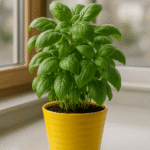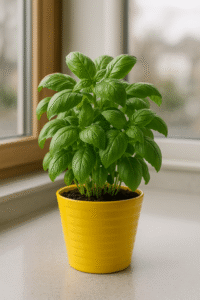Basil is one of the easiest and most flavorful indoor edible plants you can grow. Thriving with 6+ hours of direct sunlight or a quality grow light, this aromatic herb flourishes in a well-draining potting mix. Water basil when the top inch of soil dries out, keeping moisture consistent without overwatering. For best results, use a balanced liquid fertilizer monthly to boost leaf production. Start seeds or seedlings in early spring, or grow indoors year-round with artificial lighting. Expect your first harvest in 6–8 weeks. Basil not only elevates meals but adds a fresh, vibrant scent to your space—perfect for windowsills and kitchen counters.
Basil is one of the easiest and most flavorful edible herbs to grow indoors, making it a favorite among beginners and culinary enthusiasts alike. With its bright green leaves, signature aroma, and bold taste, basil is a versatile herb that enhances a wide range of dishes—from pasta and pizza to salads and infused oils. Indoors, it also adds a touch of fresh greenery and a vibrant scent to your kitchen or windowsill.
Why Choose Basil?
Basil isn’t just a garnish—it’s a kitchen essential. Its distinctive flavor elevates meals, while its natural fragrance brings freshness to your home. Growing basil indoors allows you to harvest fresh leaves year-round, control growing conditions, and avoid the wilted bundles often found in grocery stores.
Lighting Needs
Basil thrives on 6 or more hours of direct sunlight each day. A south-facing window is ideal, where the plant can soak up full sun. If you don’t have access to bright natural light, a full-spectrum LED grow light can keep your basil healthy and productive.
💡 Place grow lights 6–12 inches above the plant and keep them on for 12–14 hours daily to mimic natural sunlight.
Without enough light, basil may become leggy, pale, and slow to produce new leaves.
Choosing a Pot and Soil
Basil prefers a dedicated container that allows for deep root growth and proper drainage. Choose a pot 6–8 inches wide with ample drainage holes to prevent water buildup.
The ideal soil mix should be light, airy, and well-draining. A recommended blend includes:
- All-purpose potting soil
- Perlite for aeration
- Coconut coir or peat moss for moisture balance
This combination supports healthy roots while avoiding soggy conditions that lead to rot.
Watering and Moisture
Basil enjoys consistent moisture but is sensitive to overwatering. Water the plant when the top inch of soil feels dry to the touch. Be sure the container drains well, and empty the saucer after watering.
🚫 Avoid letting the soil completely dry out or stay waterlogged—both extremes can stress the plant and hinder growth.
Maintaining moderate indoor humidity and steady watering will help keep your basil thriving.
Feeding and Fertilizing
To encourage abundant leaf production, feed your basil monthly with a balanced liquid fertilizer diluted to half-strength. Look for an NPK ratio like 10-10-10 or 12-12-12, or opt for organic options like fish emulsion or compost tea.
🧪 Light, consistent feeding helps the plant stay vigorous without compromising its flavor.
Pruning and Harvesting
Basil grows quickly and benefits from regular harvesting. After about 6–8 weeks, begin trimming the plant by pinching off the topmost leaves, just above a leaf node (where two leaves meet the stem). This encourages the plant to branch out and become bushier.
✂️ Don’t harvest more than one-third of the plant at a time. This keeps it healthy and productive.
Keep an eye out for flower buds and remove them promptly—flowering reduces leaf flavor and signals the plant to stop growing new foliage.
Common Issues and Troubleshooting
Although basil is fairly low-maintenance, here are a few common problems to watch for:
- Yellowing leaves: Often a sign of overwatering or nutrient imbalance.
- Leggy stems: Usually due to insufficient light—move closer to a window or add a grow light.
- Pests: Occasionally, you may encounter aphids, whiteflies, or fungus gnats. Use neem oil, insecticidal soap, or a rinse with water to control infestations.
Enjoying Your Basil
Once you’ve got a healthy plant, the culinary possibilities are endless. Use basil to:
- Top off homemade pizza or pasta
- Blend into fresh pesto
- Infuse into olive oil or vinegar
- Pair with tomatoes and mozzarella in a caprese salad
- Add a herbal note to cocktails or lemonade
Beyond the kitchen, basil brings a clean, herbal scent that freshens the air naturally.
Conclusion
Growing basil indoors is a flavorful, fragrant, and fulfilling experience. With a bit of sunlight, the right potting setup, and regular care, you’ll have a steady supply of fresh basil ready to enhance your meals and your space. Whether you’re a home chef or just enjoy a touch of green indoors, basil is a must-have in any indoor garden.
- Organic edible basil seeds: Zen Basil Seeds are very nutritious organic edible basil seeds! 2 tbs of our organic seeds e...
- More fiber than chia: This superfood is known for its health-promoting properties & its natural source of fiber, vitamin...
- Highest quality: We source the high quality, sustainably grown, organic basil seeds. This superfood is high in fiber. It...
- Oregon Family Farm Business - Our company is family owned and operated on our 65 acre farm in rural Oregon. Each Spade T...
- Entire Kit Is Certified USDA Organic - Most kitchen herb garden germination kits only include organic seeds, but their s...
- The Perfect Special Gift - Our indoor herb seed kit makes a fun gift for virtually anyone -- man or woman, vegetarian or...
- 【Innovative Self Watering】- Plants take what water they need when they need it due to the integrated self-watering syste...
- 【Water Gauge】- You will never miss watering again, just see what water is needed at a glance with the water level indica...
- 【Easily grow the plant&vegetables and herbs you love! 】- No bending required with ideal growing conditions: Pick, prune ...












